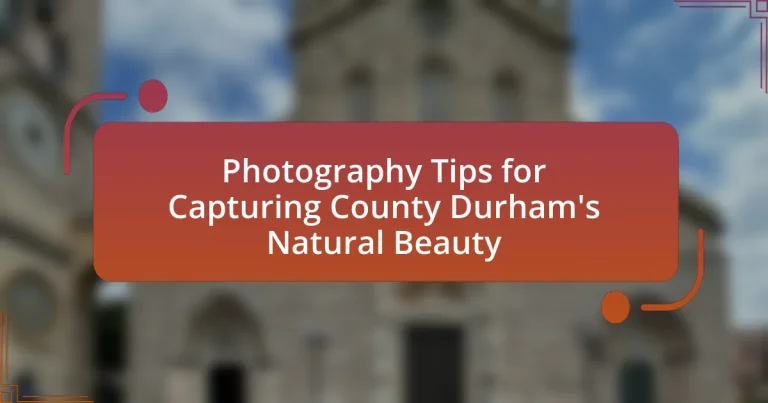The article focuses on photography tips for capturing the natural beauty of County Durham, emphasizing key elements such as composition, lighting, and subject matter. It discusses the impact of lighting conditions on image quality, the best times for shooting, and how weather influences photography outcomes. Additionally, it outlines various landscapes and iconic features to photograph, along with techniques to enhance image quality, including optimal camera settings and composition rules. Practical advice for preparation, equipment selection, and common mistakes to avoid is also provided, ensuring photographers can effectively capture the essence of County Durham’s diverse scenery.
What are the key elements of photography in County Durham’s natural landscapes?
The key elements of photography in County Durham’s natural landscapes include composition, lighting, and subject matter. Composition involves framing the scene effectively to highlight the unique features of the landscape, such as the rolling hills and river valleys. Lighting is crucial, as the golden hour—shortly after sunrise or before sunset—provides soft, warm tones that enhance the natural beauty of locations like the North Pennines Area of Outstanding Natural Beauty. Subject matter focuses on capturing iconic landmarks, such as the Durham Cathedral and the rugged moorlands, which offer diverse photographic opportunities. These elements combined allow photographers to create striking images that reflect the essence of County Durham’s landscapes.
How can lighting conditions affect photography in County Durham?
Lighting conditions significantly affect photography in County Durham by influencing the mood, clarity, and color of images. For instance, during golden hour—shortly after sunrise or before sunset—the soft, warm light enhances the natural beauty of landscapes, making features like the rugged coastline and rolling hills appear more vibrant. Conversely, harsh midday sunlight can create strong shadows and overexposed highlights, detracting from the details in the scenery. Additionally, overcast days provide diffused light, which can be beneficial for capturing the rich textures of County Durham’s historic architecture without the distraction of harsh contrasts. These variations in lighting not only impact the aesthetic quality of photographs but also dictate the best times and techniques for shooting in this picturesque region.
What are the best times of day for capturing natural beauty in County Durham?
The best times of day for capturing natural beauty in County Durham are during the golden hours, which occur shortly after sunrise and just before sunset. During these times, the soft, warm light enhances the landscape, creating dramatic shadows and vibrant colors that highlight the region’s natural features. Studies in photography emphasize that this lighting condition is optimal for landscape photography, as it adds depth and richness to images, making them more visually appealing.
How does weather influence the quality of photographs in this region?
Weather significantly influences the quality of photographs in County Durham by affecting lighting, color saturation, and atmospheric conditions. For instance, overcast skies can provide soft, diffused light that reduces harsh shadows, enhancing the details in landscapes. Conversely, bright sunlight can create high contrast and washed-out colors, which may detract from the image quality. Additionally, weather phenomena such as fog or rain can add mood and depth to photographs, creating unique compositions that highlight the region’s natural beauty. Studies have shown that the golden hour, shortly after sunrise or before sunset, offers optimal lighting conditions, resulting in more visually appealing images.
What types of landscapes can photographers expect in County Durham?
Photographers can expect diverse landscapes in County Durham, including rugged moorlands, picturesque valleys, and dramatic coastal cliffs. The North Pennines Area of Outstanding Natural Beauty features expansive heather-covered moors and rolling hills, while the Teesdale Valley offers stunning river scenery and waterfalls, such as High Force, which is one of England’s largest waterfalls. Additionally, the Durham coastline presents striking cliffs and sandy beaches, providing a variety of coastal photography opportunities. These landscapes collectively showcase the region’s natural beauty, making it a rich area for photographers to explore.
What are the most iconic natural features to photograph in County Durham?
The most iconic natural features to photograph in County Durham include High Force Waterfall, the stunning landscapes of the North Pennines Area of Outstanding Natural Beauty, and the dramatic cliffs of the Durham Heritage Coast. High Force Waterfall, one of England’s largest waterfalls, cascades 21 meters and offers breathtaking views, especially after heavy rainfall. The North Pennines, recognized for its rich biodiversity and scenic beauty, provides numerous vantage points for capturing expansive moorlands and rolling hills. The Durham Heritage Coast features striking cliffs and coastal scenery, ideal for capturing the interplay of land and sea. These locations are well-documented in photography guides and local tourism resources, affirming their status as prime photographic subjects in County Durham.
How can different terrains impact photography techniques?
Different terrains significantly impact photography techniques by influencing composition, lighting, and equipment choices. For instance, mountainous terrains may require the use of wide-angle lenses to capture expansive landscapes, while flat terrains can benefit from longer focal lengths to isolate subjects. Additionally, varying elevations can create unique lighting conditions; for example, shooting at higher altitudes may result in harsher sunlight, necessitating the use of filters to manage exposure. Furthermore, the texture and color of the terrain can dictate the choice of settings, such as aperture and shutter speed, to enhance the visual appeal of the photograph. These factors collectively shape the approach photographers must take to effectively capture the essence of diverse landscapes, such as those found in County Durham.

What techniques can enhance photography in County Durham?
To enhance photography in County Durham, utilizing techniques such as golden hour shooting, composition rules, and long exposure can significantly improve image quality. Golden hour, occurring shortly after sunrise and before sunset, provides soft, warm lighting that enhances landscapes and subjects, making them visually appealing. Applying composition rules like the rule of thirds helps create balanced and engaging images, guiding the viewer’s eye through the photograph. Additionally, long exposure techniques can capture the movement of water in locations like High Force waterfall, resulting in a smooth, ethereal effect that emphasizes the natural beauty of the area. These techniques are proven to elevate the aesthetic quality of photographs taken in County Durham’s diverse landscapes.
How can composition improve photographs of County Durham’s scenery?
Composition can significantly enhance photographs of County Durham’s scenery by guiding the viewer’s eye and creating a balanced visual narrative. Effective composition techniques, such as the rule of thirds, lead lines, and framing, can highlight the region’s unique landscapes, such as the rugged cliffs of the North Pennines or the serene beauty of the Durham Dales. For instance, placing key elements along the intersecting lines of the rule of thirds can create a more engaging image, drawing attention to focal points like the historic Durham Cathedral against the backdrop of the River Wear. Additionally, using natural elements to frame the subject can add depth and context, making the scenery more immersive. These compositional strategies not only improve aesthetic appeal but also convey the essence of County Durham’s natural beauty, making the photographs more impactful and memorable.
What are the rules of composition that photographers should follow?
Photographers should follow several key rules of composition to enhance their images. These rules include the Rule of Thirds, which suggests dividing the frame into a 3×3 grid and placing subjects along the lines or at their intersections to create balance. Another important guideline is Leading Lines, where natural lines in the scene guide the viewer’s eye toward the subject, adding depth. Framing involves using elements within the scene to create a ‘frame’ around the subject, drawing attention to it. Additionally, the use of symmetry can create visually striking images by balancing elements on either side of the frame. Lastly, the concept of Depth of Field allows photographers to control what is in focus, emphasizing the subject while blurring the background. These composition rules are widely recognized in photography literature, such as “The Photographer’s Eye” by Michael Freeman, which illustrates their effectiveness in creating compelling images.
How can leading lines and framing be used effectively in landscape photography?
Leading lines and framing can be used effectively in landscape photography by guiding the viewer’s eye through the composition and emphasizing the subject. Leading lines, such as roads, rivers, or fences, create a pathway that draws attention to the focal point, enhancing depth and perspective. Framing involves using natural elements like trees or rock formations to encase the subject, adding context and focus. Research indicates that compositions utilizing these techniques can significantly improve viewer engagement and perception of depth, as supported by studies in visual perception that highlight the importance of compositional elements in photography.
What camera settings are optimal for capturing County Durham’s beauty?
To optimally capture County Durham’s beauty, use a low ISO setting (100-200) to minimize noise, a wide aperture (f/2.8 to f/5.6) for a shallow depth of field, and a shutter speed of 1/125 seconds or faster to freeze motion. These settings enhance image clarity and detail, particularly in the region’s diverse landscapes, such as the rugged moors and historic architecture. The low ISO reduces graininess, while the wide aperture allows for beautiful background blur, emphasizing the subject. A faster shutter speed is essential for capturing the dynamic elements of the scenery, such as flowing rivers or wildlife.
How do aperture, shutter speed, and ISO settings affect landscape photography?
Aperture, shutter speed, and ISO settings significantly influence landscape photography by controlling exposure, depth of field, and image noise. Aperture affects the amount of light entering the camera and determines depth of field; a smaller aperture (higher f-stop number) increases depth of field, keeping more of the scene in focus, which is essential for landscape shots. Shutter speed controls the duration the sensor is exposed to light; slower shutter speeds can create motion blur in elements like flowing water, adding a dynamic quality to landscapes. ISO measures the sensor’s sensitivity to light; a lower ISO reduces noise, which is crucial for capturing fine details in landscapes, especially in bright conditions. For instance, using an aperture of f/16, a shutter speed of 1/125 seconds, and an ISO of 100 can yield sharp, well-exposed landscape images.
What are the recommended settings for different lighting conditions?
For bright daylight conditions, use a low ISO setting (100-200), a fast shutter speed (1/500s or faster), and an aperture of f/8 to f/11 to achieve sharp images with good depth of field. In overcast or shaded conditions, increase the ISO to 400-800, use a slower shutter speed (1/125s), and open the aperture to f/4 to f/5.6 to allow more light. For low-light situations, such as during dusk or dawn, set the ISO to 800-1600, use a slower shutter speed (1/60s or slower), and open the aperture to f/2.8 or wider to capture sufficient light. These settings are based on standard photography practices that optimize exposure and image quality across varying lighting conditions.
What practical tips can photographers use when capturing County Durham’s natural beauty?
Photographers can enhance their capture of County Durham’s natural beauty by utilizing the golden hour for optimal lighting. This period, shortly after sunrise and before sunset, provides soft, warm light that enhances landscapes and highlights textures. Additionally, incorporating foreground elements, such as wildflowers or rocks, can create depth and interest in compositions. Utilizing local landmarks, like the stunning Durham Cathedral or the rugged North Pennines, can provide context and scale to nature shots. Finally, experimenting with different perspectives, such as low angles or aerial views, can reveal unique aspects of the scenery, showcasing County Durham’s diverse landscapes effectively.
How can photographers prepare for a successful shoot in County Durham?
Photographers can prepare for a successful shoot in County Durham by researching the location, understanding the weather conditions, and planning their equipment accordingly. Researching the area allows photographers to identify key landmarks and natural features, such as the stunning landscapes of the North Pennines or the historic sites like Durham Cathedral. Understanding the weather is crucial, as County Durham experiences varied conditions that can affect lighting and visibility; for instance, overcast days can provide soft, diffused light ideal for capturing details. Additionally, photographers should prepare their equipment by ensuring they have the right lenses for landscape photography, tripods for stability, and extra batteries to avoid interruptions during the shoot.
What equipment should photographers bring for landscape photography?
Photographers should bring a DSLR or mirrorless camera, a sturdy tripod, a wide-angle lens, and neutral density filters for landscape photography. A DSLR or mirrorless camera allows for high-quality images and versatility in settings, while a sturdy tripod ensures stability for long exposures and sharp images. A wide-angle lens captures expansive landscapes effectively, and neutral density filters help manage exposure in bright conditions, allowing for creative effects like smooth water surfaces. These pieces of equipment are essential for achieving professional results in landscape photography.
How can scouting locations in advance improve photography outcomes?
Scouting locations in advance significantly enhances photography outcomes by allowing photographers to identify optimal angles, lighting conditions, and unique features of the landscape. By visiting a site beforehand, photographers can assess the terrain, plan compositions, and determine the best times for shooting based on the sun’s position, which is crucial for capturing the natural beauty of locations like County Durham. Research indicates that pre-visualization of shots can lead to more creative and impactful images, as photographers can anticipate challenges and adapt their techniques accordingly.
What common mistakes should photographers avoid in County Durham?
Photographers in County Durham should avoid common mistakes such as neglecting to consider lighting conditions, failing to scout locations beforehand, and overlooking the importance of composition. Poor lighting can lead to unflattering images, as the region’s natural beauty is best captured during golden hours—early morning or late afternoon. Not scouting locations can result in missed opportunities for unique shots, especially in a diverse landscape like County Durham, which includes coastal areas, moors, and historic sites. Additionally, ignoring composition principles, such as the rule of thirds, can detract from the visual impact of photographs, making them less engaging. These mistakes can significantly diminish the quality of the photographs taken in this picturesque area.
How can overexposure and underexposure be prevented in landscape shots?
To prevent overexposure and underexposure in landscape shots, photographers should utilize exposure compensation settings on their cameras. This feature allows for adjustments to the exposure level, enabling the photographer to correct for bright or dark scenes. Additionally, using a histogram to evaluate exposure levels can provide visual feedback, ensuring that highlights and shadows are well-balanced. Employing graduated neutral density filters can also help manage the dynamic range between bright skies and darker landscapes, effectively reducing the risk of overexposure in highlights and underexposure in shadows.
What are the pitfalls of ignoring the foreground in landscape photography?
Ignoring the foreground in landscape photography can lead to compositions that lack depth and interest. Foregrounds serve as essential elements that draw viewers into the scene, providing context and scale. Without a compelling foreground, images may appear flat and unengaging, diminishing the overall impact of the landscape. Studies in visual perception indicate that viewers are more likely to connect with images that include layered elements, as they create a sense of three-dimensionality. Therefore, neglecting the foreground can result in missed opportunities to enhance storytelling and emotional resonance in landscape photography.




